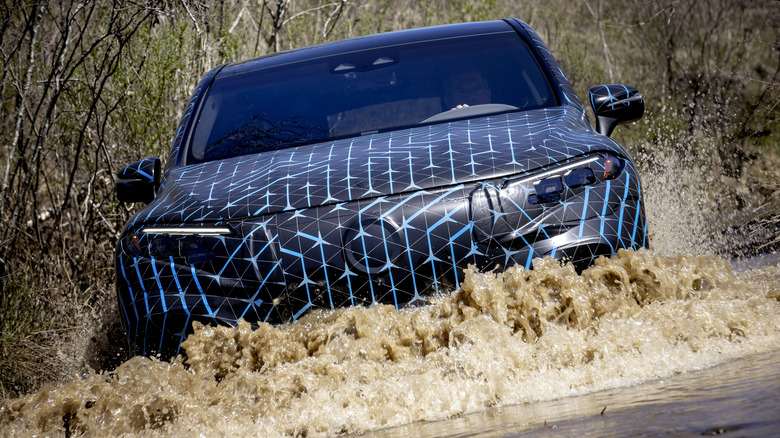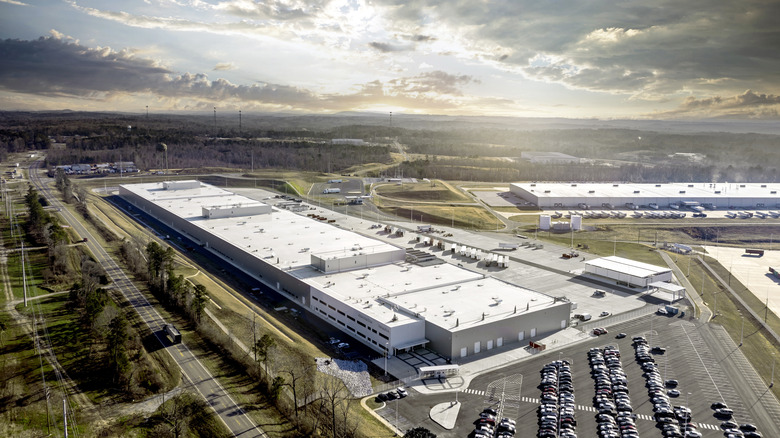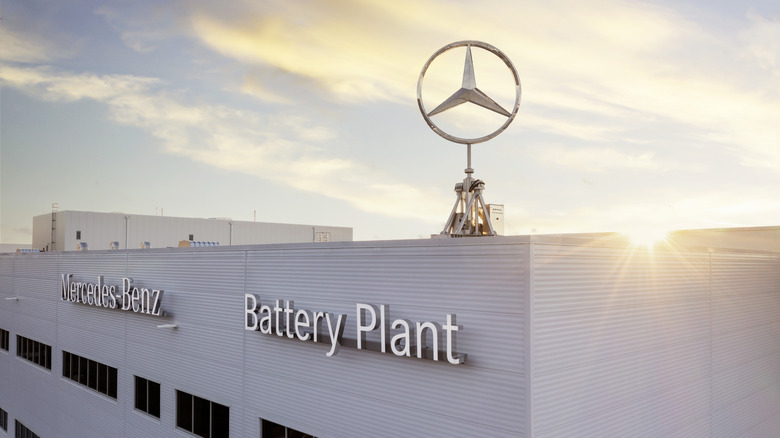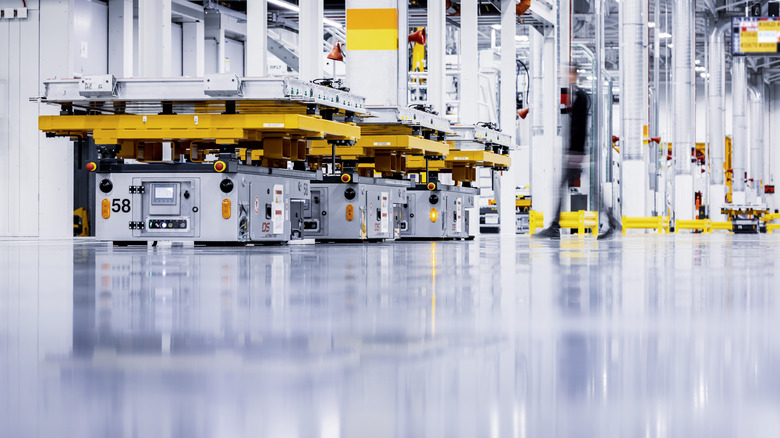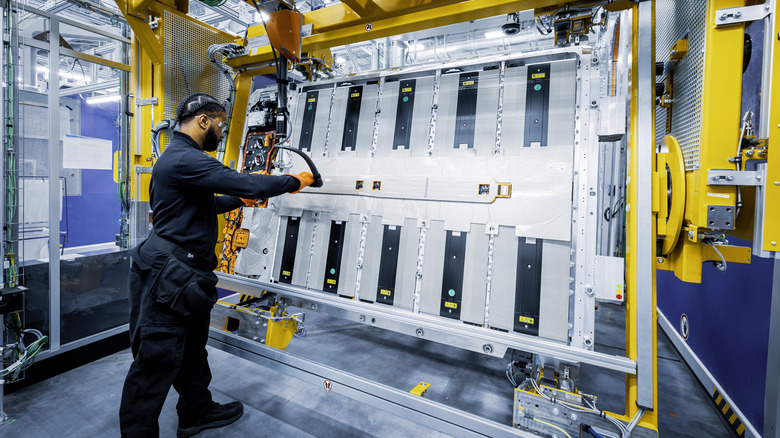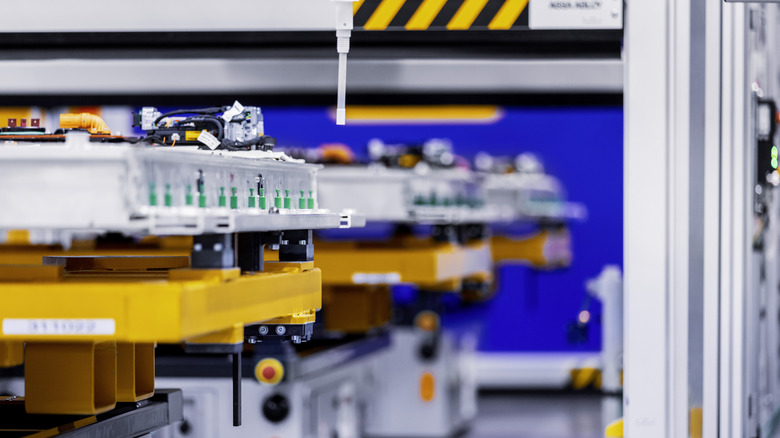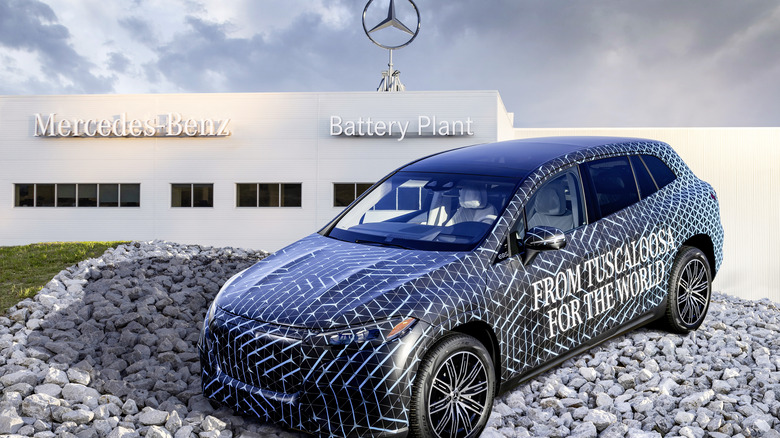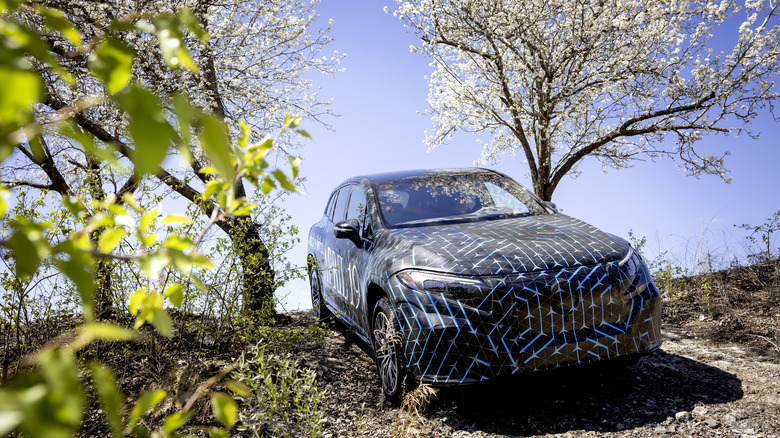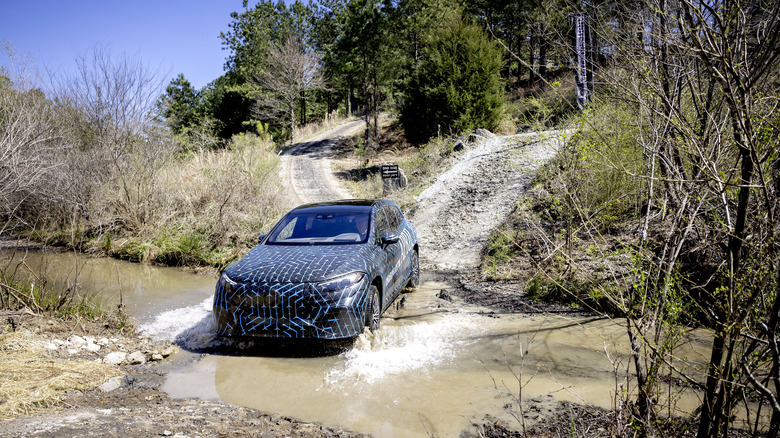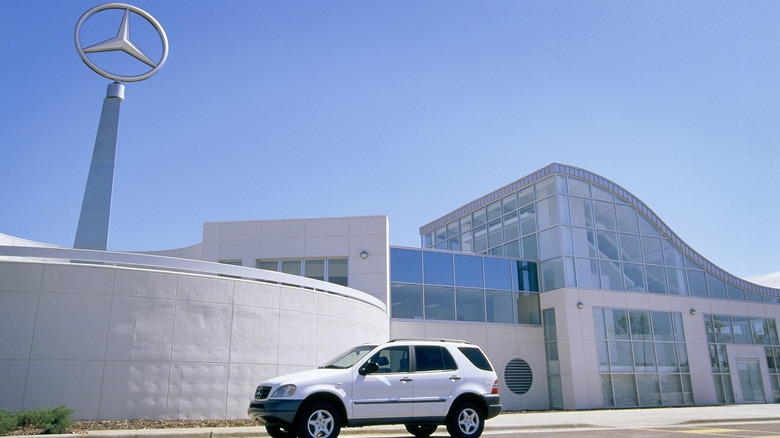2023 Mercedes EQS SUV Ride-Along: Lithium, Cobalt, And A Whole Lot Of Mud
Twenty-five years. A whole quarter-century. My 1997 Toyota RAV4 – the first car I've ever owned in my four-plus decades of life – will turn 25 at the end of April. It's not silver (the traditional gift for a 25th anniversary), but it's quite the time capsule. No infotainment. No TFT instrument panels. Not even SiriusXM. All three of those things can be had on the current generation RAV4, the fifth such version of the compact crossover.
Do you know what else turns 25 this year, though? The Mercedes-Benz M-Class. Though the W163 era had no infotainment, TFTs or SiriusXM back then – none of those things existed – it debuted with a feature my RAV4 didn't have: electronic stability control. That alone helped set Stuttgart's first non-G-Class SUV apart from the rest of the burgeoning luxury SUV market. Throw in side and front airbags with advanced occupant detection, plus an optional third row, and you have the start of an SUV unlike any other. What else in 1997 could top that?
Sweet Home Alabama
By building it in the United States, of course. Though Mercedes produced around 6,000 trucks per year in Hampton, Virginia in the 1980s, no cars were built in the U.S. The powers that be in Germany, though, re-examined their relationship with their customers around the world while building its globalization strategy. Said strategy included establishing a major presence in global markets in their effort to be closer to its customers.
Thus, in 1993, the stage was set for Mercedes' first-ever passenger vehicle plant in the United States, selecting Vance, Alabama as the home for what would be known to this day as Mercedes-Benz U.S. International, Inc. – MBUSI, for short. Fast-forward to 1997, and the first M-Class makes its way through the first U.S. Mercedes plant, contributing a milestone to a year full of them, from ThrustSSC breaking the sound barrier on land in the Nevada desert and IBM's Deep Blue supercomputer beating chess world champion Garry Kasparov in a rematch, to the launch of the Cassini-Huygens mission to Saturn and the late Steve Jobs returning to Apple after a 12-year exile.
Standing on the edge of a silver future
A quarter-century since the day the first-ever M-Class – dubbed the GLE-Class since 2015 – left MBUSI (it was an ML 320, by the by), technology marches on. One of the largest shifts for the car is the ramp up towards total electrification. Mercedes-Benz is among the growing number of manufacturers joining the revolution, having introduced its EQ family to the world with the EQC SUV in 2018 for the 2019 model year. One of the goals for the EQ line back then was to have 10 members of the family by 2022, all based on a single modular platform.
Fast-forward to 2022, where, despite the COVID-19 pandemic throwing all of the wrenches into the works for the past two years, Mercedes is on its way to achieving its first goal with the EQ family. Two members, the upcoming EQS and EQE SUVs, will soon leave the same facility as the current GLS and GLE. Their battery packs won't need to travel far, either, for MBUSI has a new addition, in the form of the Mercedes-Benz Battery Plant: the first such plant operated by the company in the United States. It's one of eight cell factories around the world, with all eight contributing to the total planned production capacity of 200 Gigawatt hours by the end of the New '20s. And that goal is important for a major reason: Mercedes aims to go completely electric by 2030 in markets where it is feasible to do so.
Supplying the future of Mercedes
"Envision AESC will be a major supplier securing capacity for the next generations of our Mercedes-EQ products built in the U.S. in the years to come," said Mercedes Chief Technology Officer, Markus Schaefer. "With Envision AESC's net-zero carbon solutions and battery technology, this new cooperation underlines our holistic approach regarding our sustainable value chain and allows us to secure supplies, to take advantage of economies of scale, and to provide our customers with superior battery technology."
Originally known as Automotive Energy Supply Corporation prior to China's Envision Group's majority stake purchase in 2018, Envision AESC will not only supply the cell modules needed to build the packs for the EQS and EQE SUVs, but also plans to establish a gigafactory in the United States in order to begin supplying the plant with said modules starting in the middle of the New '20s. Envision AESC joins Taiwan's ProLogium Technology as Mercedes new battery partners. ProLogium, who signed a technical cooperation agreement with the company back in January 2022, is a leading producer of solid-state lithium ceramic batteries, the next step in the evolution of both battery technology and electric vehicles.
What do you do with recycled lithium, anyway?
Two of Mercedes' goals with all of their battery plants – including the newest plant in Alabama – is to reduce the use of cobalt to zero percent, as well as recycle the lithium once the cells are no longer viable for reconditioning/remanufacturing in battery pack production. Thus, three questions came up in my mind upon learning of this:
- What does one do with recycled lithium?
- What role does cobalt play in battery production?
- Why the need to reduce cobalt use to zero?
Luckily, a roundtable with Markus Schaefer helped answer these questions.
"We have a company – Mercedes-Benz Energy – that uses batteries for second life," Schaefer said, "for larger applications. [They] put them together [...] as a back-up system or stabilizing system in networks, ultimately recycling [them]."
Lithium recycling is still new, of course, due to the expense involved versus mining and brine-pool extraction, the technology to recycle lithium still in its early stage, and the fact that lithium-ion batteries overall not designed for proper recycling. The main driver for increased recycling of lithium will be the need to reuse the metals in lithium nickel manganese cobalt oxide cathodes, especially cobalt, which Mercedes would like to eliminate from its batteries entirely; they've already achieved 90% elimination from their packs thus far.
Removing cobalt from the equation
"[Cobalt is used in] stabilizing the battery," said Schaefer. "It makes the battery chemistry more stable. We want a very safe and stable battery chemistry; [cobalt's] helping there. But we are able to push cobalt – which is a critical material, from our standpoint, in terms of mining and location, where it's mined. It's a critical material we want to see getting out of the battery. We do see that there are chances to cobalt-free [...] I would say within the next couple of years, we'll probably see cobalt-free batteries."
Though cobalt was already in use in lithium-ion battery production for smartphones, the rise and subsequent boom in electric vehicle production drove up the need to source and mine the chemical element. The need to reduce the use of cobalt to zero will help contribute to the sustainability of its use overall, as the element is used in everything from batteries to alloys and catalysts (including the carboxylates used in improving the adhesion between steel and rubber in steel-belted tires). And, of course, in coloring and pigments, since cobalt brings the blue to glassware and ceramics.
Thus, one reason why (cobalt) blue is a theme for electric vehicles like the upcoming Mercedes EQS SUV.
Going for a rough ride in the new big daddy of Mercedes SUVs
Mercedes-Benz currently has one flagship EQ: the EQS. Take the flagship S-Class formula, apply it to the company's MEA EV platform, and give it the ability to slip through the air with a drag coefficient of 0.20, the lowest such measure found in any current production vehicle. Not even Tesla, the beta test for overall commercial viability of EVs, has anything quite like the EQS.
Mercedes isn't done, though. Coming April 19, it will debut its second flagship EQ, the EQS SUV. Built in the same plant as the GLS and GLE SUVs, the big daddy EV SUV is already 99% ready to go. So much so that I got to ride shotgun on a co-drive through MBUSI's off-road course the day before the grand unveiling of the company's first U.S. battery plant. I had never been off-roading ever before; to do so in an electric SUV took things to another level.
In case you need to, the EQS SUV proves it can
Though this is a pre-production model, the EQS SUV left quite the impression on me. One of the first features demonstrated to me was its ability to know when a driver's eyes are off the road (or, in this case, the great outdoors). The Hyperscreen on my side of the ride showed me a film of the flagship EQ SUV traversing desert sands and other environments. However, it clicked off with a notice that the driver had looked upon it instead of out of the windshield. All to improve driver safety amid such a dazzling display of technology, to be sure, though it might inspire a few front-seat passengers to punch the driver for interrupting the movie they were watching.
As far as its off-road capability goes, though, the EQS SUV won't be climbing the rocks of Moab with Jeeps and Broncos. Most of its future owners also won't be going off-road in it, if in any machine, either. Yet, those who do make use of the EV SUV's capabilities won't be disappointed. From the rear-wheel steering helping to thread the big SUV through some tight, tree-lined corners, to the air suspension lifting up to allow easier descent over hills, the EQS SUV is ready to lay claim to more than a few unbeaten paths once copies set out from Alabama in the months to come.
A journey of a thousand miles begins in Alabama
When MBUSI opened 25 years ago, Mercedes-Benz CEO Ola Källenius had just taken his first job within the company. Today, he's overseen another major milestone occur in Alabama, this one next door to where he was way back when. How do these two events – MBUSI's opening in 1997, and the Mercedes U.S. battery plant opening in 2022 – compare in his mind?
Something like this:
"Every time I come back [to Alabama], this is a happy place," said Källenius. "I have fond memories and feelings, great friends [...] Now that I've come back, I combine that positive mindset with kind of a sense of pride of this team and what they have been able to achieve. I remember when we sat in the office back in 1994, and they said, 'Okay. We're gonna build our first [U.S.] plant, but in Alabama.' There was an American guy across from me who said, 'You ever been to Alabama?' For us, it was a pioneering adventure.
"And where are we now?" Källenius continued. "Five OEMs. Literally triple-digit number of suppliers [...] We are the biggest exporter out of Alabama, one of the biggest industrial exporters out of the United States of America [...] One of the best business decisions that we have ever made. It's a sense of pride."
To the next 25 years
Twenty-five years are but a quarter of a human life (until life-extension technology improves, that is). Yet, it's a long time as far as history and technology is concerned. In 1997, we still used film cameras for everything. In 1997, there wasn't an iPhone or Pixel (let alone a Google to build the latter). And, in 1997, Mercedes-Benz built its first non-G-Wagen SUV in the most unlikely of places, a new plant in the Southeastern United States.
Twenty-five years later in 2022, film photography is undergoing a renaissance, though not to where it will once again be the end-all, be-all of photography. In fact, digital photography, including the iPhone and Pixel, have firmly taken control of the scene, among other aspects of daily and professional life. Meanwhile, Alabama is still the U.S. home for Mercedes-Benz, which produced over 260,000 GLS and GLE SUVs in 2021, each one touched by one of 4,500 employees, plus 11,000 more from the various suppliers involved.
The new Mercedes-Benz Battery Plant next door will add up to 600 new jobs to the local economy. More than that, though, it'll also help MBUSI – and Mercedes-Benz overall – traverse the next 25 years. The future is not written, but may it be something we can all look back fondly upon when 2047 rolls around.
